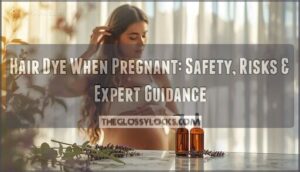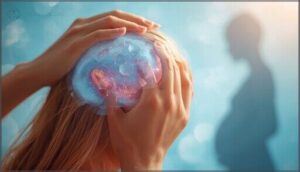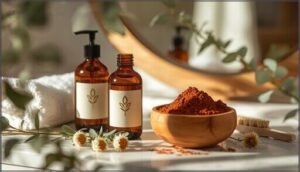This site is supported by our readers. We may earn a commission, at no cost to you, if you purchase through links.
You spot your roots in the mirror and reach for the dye box, then freeze. Pregnancy turns routine beauty decisions into medical calculations. Most doctors confirm that hair dye is safe during pregnancy because the chemicals don’t reach your baby in harmful amounts.
The scalp absorbs only trace quantities of ammonia, PPD, and hydrogen peroxide—far too little to cross the placenta at concerning levels. But understanding which ingredients matter, when timing helps, and how ventilation protects you makes the difference between unnecessary worry and informed confidence.
Your healthcare provider can address your specific medical history, while simple precautions like wearing gloves and choosing ammonia-free formulas reduce exposure even further.
Table Of Contents
Key Takeaways
- Hair dye is safe during pregnancy because only trace amounts of chemicals like ammonia and PPD absorb through your scalp—far too little to reach your baby at harmful levels.
- Wait until after your first trimester if possible, since that’s when your baby’s organs form, though no studies prove dye causes birth defects at any stage.
- Simple precautions like using ammonia-free formulas, wearing gloves, working in ventilated spaces, and choosing techniques that avoid scalp contact reduce your chemical exposure even further.
- Talk with your doctor about your specific medical history before dyeing, especially if you have skin conditions or allergies that might increase absorption rates.
Is Hair Dye Safe During Pregnancy?
Most doctors say hair dye is safe during pregnancy. The chemicals don’t reach your baby in harmful amounts.
Here’s what the medical community agrees on, what research tells us, and which pregnancy myths you can stop worrying about.
Current Medical Consensus
Most professional guidance confirms hair dye during pregnancy carries no confirmed fetal risk when you follow product directions. Regulatory and clinical sources emphasize precautionary use—minimize scalp exposure and guarantee proper ventilation.
Chemical exposure during pregnancy through hair dye involves limited systemic absorption, reducing fetal development concerns.
Expert recommendations support discussing your medical history with a healthcare provider for tailored pregnancy safety advice.
What Scientific Studies Show
Research on hair dye risks paints a reassuring picture. Large studies find no consistent link between chemical exposure during pregnancy and adverse fetal development outcomes. Toxicology research shows minimal systemic absorption from typical dye formulation use. Fetal risk assessment remains limited by study design challenges, yet available pregnancy outcomes data don’t support avoiding all hair dye. Most evidence suggests careful, occasional use poses low risk.
Large studies show no consistent link between hair dye use during pregnancy and fetal harm when used carefully and occasionally
- No proven teratogenic effects from standard hair dye during pregnancy
- Scalp absorption of dye chemicals remains low with brief application
- Observational studies show no increased congenital anomalies from intermittent use
- Sample sizes and recall bias limit definitive toxicology research conclusions
- Regulatory agencies recommend precaution but don’t mandate complete avoidance
Further studies on methodological rigor can be found using scientific auditing tools to assess research quality.
Common Misconceptions
Despite the reassuring data, several myths persist. You might hear that ammonia always harms fetal development or any scalp contact causes birth defects—both false.
Hair dye isn’t completely unsafe at any stage, and temporary dyes aren’t entirely risk-free either. Understanding these pregnancy facts helps separate cosmetic safety concerns from legitimate chemical risks, giving you confidence in your hair care choices.
How Hair Dye Chemicals Affect Pregnancy
Hair dye contains several chemical ingredients that may raise questions during pregnancy. These chemicals are absorbed through your scalp in small amounts.
Understanding what’s in your hair dye and how it interacts with your body helps you make informed choices.
Chemical Ingredients to Know
Hair dye contains chemicals that deserve your attention. Understanding what’s in your product helps you make informed choices about toxic exposure during pregnancy.
Here are the main chemical ingredients to know:
- Ammonia – Opens your hair cuticle, releasing fumes that can irritate your airways
- Paraphenylenediamine (PPD) – A colorant found in permanent dyes that may trigger dye allergens and skin reactions
- Hydrogen peroxide – Develops color but increases chemical reactions on your scalp
- Resorcinol – A color developer linked to skin irritation and potential toxicity concerns
- PPD alternatives – Marketed as gentler substitutes, though colorant risks vary by formula
Absorption Through The Scalp
Your scalp absorbs only tiny amounts of hair dye chemicals. Studies show about 26% of applied dye penetrates skin layers over 24 hours, with most trapped in dead outer cells rather than reaching your bloodstream. Damaged scalp barrier from eczema or cuts increases skin permeability and chemical uptake. Rinsing after 30 minutes removes nearly half the product, limiting dermal penetration and potential fetal exposure.
When making decisions about coloring your hair during pregnancy, you should keep in mind hair dye safety.
Potential Risks to The Fetus
Evidence from available human studies shows no consistent pattern of birth defects or fetal development problems linked to topical hair dye use during pregnancy. The small amounts absorbed through your scalp don’t reach toxic levels in your bloodstream.
Animal studies using doses far higher than typical consumer exposure haven’t demonstrated serious toxicity or increased pregnancy risks, offering reassurance about fetal safety.
When is It Safest to Dye Hair?
Most experts agree that you can dye your hair during pregnancy, but timing matters. The first trimester deserves extra caution since that’s when your baby’s organs are forming.
Here’s what you need to know about when to schedule your color appointments and how often it’s safe to dye.
First Trimester Precautions
The first three months carry heightened caution around chemical exposure because fetal development happens fast. Your baby’s organs form during this window, so limiting unnecessary toxins makes sense.
Most doctors suggest waiting until after week twelve if you can. If you decide to dye earlier, choose ammonia-free products, maintain strong ventilation safety, and keep the dye off your scalp during application.
Timing Recommendations From Experts
Most obstetric experts agree: you can safely color your locks after the first trimester. The second trimester offers a sweet spot—fetal organs are formed, and your body manages cosmetic safety better.
Expert consensus leans toward postponing dye application until at least week thirteen for fetal protection. If you’re anxious earlier, talk to your doctor about pregnancy-safe formulations and timing that fits your unique situation.
Frequency of Dye Use
How often should you color your hair during pregnancy? There’s no universal rule, but less is more regarding dye application. Space out hair coloring sessions to minimize chemical exposure. Most clinicians suggest limiting treatments rather than dyeing every few weeks.
If you have sensitive skin or scalp conditions, reducing frequency becomes even more important. Discuss your hair care routine with your doctor—they’ll help you balance safety measures with your personal preferences and pregnancy risks.
Precautions for Hair Dye Use While Pregnant
If you choose to dye your hair during pregnancy, a few simple precautions can make the process safer.
These steps help reduce your exposure to chemicals and minimize potential risks. Here’s what you should do.
Application in Ventilated Areas
When you dye your hair while pregnant, proper ventilation isn’t optional—it’s essential. Breathing in chemical fumes can increase your exposure beyond what your scalp absorbs alone. Opening a window helps, but true hair dye safety requires more deliberate air quality control.
- Use spaces with 6–12 air changes per hour to dilute airborne contaminants effectively
- Position portable extractors near your workstation to capture vapors at their source
- Avoid enclosed bathrooms where fumes can concentrate and linger during processing time
Well-ventilated areas protect both you and your baby from unnecessary chemical inhalation.
Protective Measures (Gloves, Avoiding Scalp Contact)
Beyond good airflow, physical barriers matter just as much. Gloves prevent skin absorption through your hands during application. You’ll want to keep dye off your scalp entirely—techniques like balayage naturally create distance between chemicals and skin. A patch test 48 hours before full application catches allergic reactions early.
| Protection Method | How It Works | Key Benefit |
|---|---|---|
| Disposable gloves | Block hand contact with chemicals | Prevent direct skin absorption |
| Scalp-free techniques | Apply color to hair strands only | Minimize chemical exposure routes |
| Barrier creams | Create protective layer on hairline | Reduce accidental skin contact |
These simple steps cut your chemical exposure markedly.
Safer Alternatives and Product Choices
You don’t have to skip hair color completely during pregnancy. Several options let you freshen up your look with less chemical exposure.
Here are some safer choices that keep both style and peace of mind intact.
Ammonia-Free and Vegetable-Based Dyes
You can choose ammonia-free hair dye options that reduce scalp irritation and odor during pregnancy. These formulas often substitute monoethanolamine, which may still cause mild reactions in sensitive skin.
Vegetable-based dyes like henna offer natural alternatives with orange to reddish tones, though results vary by hair base.
Always check labels for additives and perform patch tests before full application to confirm safety.
Temporary and Semi-Permanent Options
If ammonia-free options still feel too strong, temporary dyes and semi-permanent color offer even gentler formulas. Temporary color washes out after one or two shampoos, while semipermanent color lasts four to twelve washes without deep scalp penetration. Both deposit color on the hair surface with low chemical exposure.
You’ll still need patch tests and good ventilation, but these choices minimize contact during pregnancy.
Highlights, Balayage, and Natural Lighteners
Highlights and balayage keep color off your scalp, reducing direct skin contact with chemicals. These techniques lighten hair strands instead of coating your entire head. Professionals apply product with careful weaving, limiting exposure during pregnancy.
Natural lighteners like chamomile or lemon juice offer mild tone shifts without ammonia or peroxide. Each option requires patch testing and realistic expectations about color deposits and fetal development safety.
Consulting Your Healthcare Provider
Your doctor knows your medical history better than anyone. They can give you advice that fits your specific situation and address any concerns you have about hair dye during pregnancy.
Here’s what to discuss with your healthcare provider.
Discussing Concerns and Medical History
Before you dye your hair, share your full medical disclosure with your obstetrician. Your prenatal care depends on transparency about pregnancy risks that might affect you and your fetus. Discuss:
- Previous pregnancy outcomes and reproductive health concerns
- All current medications that could trigger medication interactions
- Skin allergies or conditions like eczema that increase chemical absorption
- Family history of thyroid or autoimmune disorders
This conversation shapes safer obstetric care decisions.
Personalized Recommendations
Your provider builds tailored plans around your pregnancy stages, skin sensitivity, and personal preferences. Risk assessment considers your medical history and trimester to deliver medical guidance on timing and dye type.
Whether you want ammonia-free formulas or highlights, cosmetic safety and pregnancy precautions align with your goals. This pregnancy and hair dye safety approach respects beauty product safety while protecting your health. Hair care during pregnancy becomes individual medicine.
Monitoring for Adverse Reactions
Watch for signs of allergic reaction within 72 hours after applying dye. Skin irritation, rash, or swelling signals contact dermatitis from chemical exposure. Severe anaphylaxis symptoms like facial swelling or breathing trouble need emergency care immediately.
A patch test before use helps prevent reactions. If you notice new headaches or vision changes, seek medical evaluation.
Document any reaction details to guide your provider’s assessment and protect future skin absorption risks.
Frequently Asked Questions (FAQs)
Can hair dye cause allergic reactions during pregnancy?
You can develop an allergic reaction to hair dye during pregnancy. Patch testing 48 hours before application helps detect sensitivity. Always use gloves and avoid scalp contact to minimize chemical exposure.
Does breastfeeding affect hair dye safety decisions?
Most breastfeeding mothers can dye their hair safely. Breast Milk Safety isn’t compromised because Dye Ingredient Risks remain minimal—very little enters your system. Standard Lactation Precautions like ventilation protect both Maternal Guidance and Infant Exposure concerns effectively.
Are salon treatments safer than home dye kits?
Salon appointments usually offer better ventilation and professional guidance on dye application, reducing chemical exposure. However, cosmetic safety depends more on product choice and pregnancy precautions than setting alone.
Can hair texture changes during pregnancy affect results?
Yes, pregnancy hormones can shift hair texture and porosity, affecting dye absorption. Changes like increased curl or frizz may create uneven color uniformity. However, most people see minimal differences in their hair care results.
Do certain hair colors contain more harmful chemicals?
Darker permanent formulations generally carry higher pigment precursor loads, including toluene-2,5-diamine sulfate, compared to lighter shades.
Ammonia-free and semi-permanent options across all color families offer reduced chemical absorption rates during pregnancy.
Conclusion
You weigh the research, you choose safer products, you protect your baby—and you still get to feel like yourself. Hair dye when pregnant carries minimal risk when you follow basic precautions. The chemicals don’t penetrate deeply enough to harm your developing child.
Your choices matter, but they don’t require sacrifice. Talk with your doctor about your specific situation. Then color your hair with confidence, knowing you’ve made an informed decision that works for both of you.
- https://www.sciencedirect.com/science/article/pii/S0749208123000268
- https://github.com/tugcekonuklar/msc-computer-science-notes/blob/main/research-methods/Home.md
- https://pmc.ncbi.nlm.nih.gov/articles/PMC2567273/
- https://wte.onelink.me/85iI/7s0l3a5z
- https://forums.thebump.com/discussion/7266617/whats-your-opinion-on-coloring-your-hair-during-pregnancy











